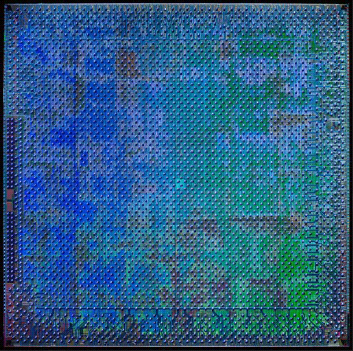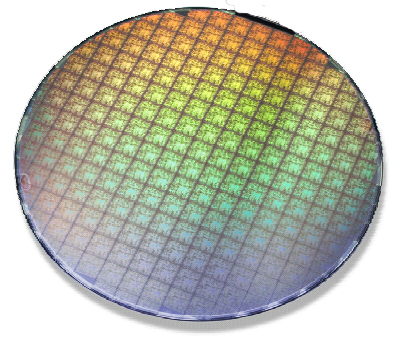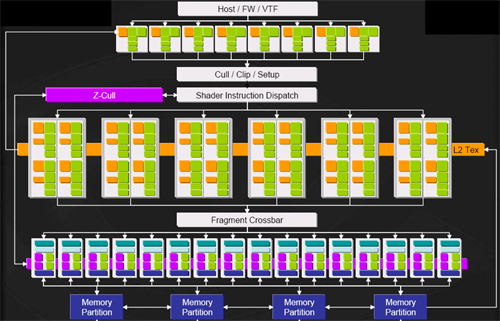NVIDIA's GeForce 7800 GTX Hits The Ground Running
by Derek Wilson on June 22, 2005 9:00 AM EST- Posted in
- GPUs
The Pipeline Overview
First, let us take a second to run through NVIDIA's architecture in general. DirectX or OpenGL commands and HLSL and GLSL shaders are translated and compiled for the architectures. Commands and data are sent to the hardware where we go from numbers, instructions and artwork to a rendered frame.The first major stop along the way is the vertex engine where geometry is processed. Vertices can be manipulated using math and texture data, and the output of the vertex pipelines is passed on down the line to the fragment (or pixel) engine. Here, every pixel on the screen is processed based on input from the vertex engine. After the pixels have been processed for all the geometry, the final scene must be assembled based on color and z data generated for each pixel. Anti-aliasing and blending are done into the framebuffer for final render output in what NVIDIA calls the render output pipeline (ROP). Now that we have a general overview, let's take a look at the G70 itself.

The G70 GPU is quite a large IC. Weighing in at 302 million transistors, we would certainly hope that NVIDIA packed enough power in the chip to match its size. The 110nm TSMC process will certainly help with die size, but that is quite a few transistors. The actual die area is only slightly greater than NV4x. In fact, NVIDIA is able to fit the same number of ICs on a single wafer.

A glance at a block diagram of the hardware gives us a first look at the methods by which NVIDIA increased performance this time around.

The first thing to notice is that we now have 8 (up from 6) vertex pipelines. We still aren't vertex processing limited (except in the workstation market), but this 33% upgrade in vertex power will help to keep the extra pixel pipelines fed as well as handle any added vertex load developers try to throw at games in the near future. There are plenty of beautiful things that can be done with vertex shaders that we aren't seeing come about in games yet like parallax and relief mapping as well as extended use of geometry instancing and vertex texturing.
Moving on to pixel pipelines, we see a 50% increase in the number of pipelines packed under the hood. Each of the 24 pixel pipes is also more powerful than those of NV4x. We will cover just why that is a little later on. For now though, it is interesting to note that we do not see an increase in the 16 ROPs. These pipelines take the output of the fragment crossbar (which aggregates all of the pixel shader output) and finalizes the rendering process. It is here where MSAA is performed, as well as the color and z/stencil operations. Not matching the number of ROPs to the number of pixel pipelines indicates that NVIDIA feels its fill rate and ability to handle current and near future resolutions is not an issue that needs to be addressed in this incarnation of the GeForce. As NVIDIA's UltraShadow II technology is driven by the hardware's ability to handle twice as many z operations per clock when a z only pass is performed, this also means that we won't see improved performance in this area.
If NVIDIA is correct in their guess (and we see no reason they should be wrong), we will see increasing amounts of processing being done per pixel in future titles. This means that each pixel will spend more time in the pixel pipeline. In order to keep the ROPs busy in light of a decreased output flow from a single pixel pipe, the ratio of pixel pipes to ROPs can be increased. This is in accord with the situation we've already described.
ROPs will need to be driven higher as common resolutions increase. This can also be mitigated by increases in frequency. We will also need more ROPs as the number pixel pipelines are able to saturate the fragment crossbar in spite of the increased time a pixel spends being shaded.










127 Comments
View All Comments
mrdeez - Thursday, June 23, 2005 - link
also:maybe gaming in hi def......ona big screenmrdeez - Thursday, June 23, 2005 - link
#114Dude just stfu......we are here to comment what we want and say it freely......minus threats and name calling....as i said before this card is not for gamers...maybe elite gamers that have a monitor that does these resolutions but most gamers i know have went to lcd and i have yet to see any lcd[im sure there are some]do these resolutions so this card really is a card for crt elite gamers......lol with those resolutions on a 21 inch monitor you would need binoculars as glasses to play the game....the tanks on bf2 would be ant like small....
bob661 - Thursday, June 23, 2005 - link
#114I am SO glad that Anand remains in business despite all the bitches that are in these comment sections.
Locut0s - Thursday, June 23, 2005 - link
Those who are complaining that they should have reviewed at lower resolutions should think for a minute. First of all you are talking about a 600 buck card, most people who have that kind of money to spend on a card also have a monitor that is capable of 1600x1200 or better. Also benchmarking at any lower resolution on a card like this in todays games is almost pointless as you are almost entirely CPU bound at those resolutions. Do you really want to see page after page of 1024x768 charts that differ by only 4-5 percent at the most?Also give the editors a break when it comes to writing these articles. As others have said this is not a subscription site and given the number of visitors and the quality of the articles I'm amazed, and gratified, that the people of Anandtech keep putting out article after long article despite all the winning that goes on over spelling mistakes and graph errors that more often than not are corrected within a few hours.
SDA - Thursday, June 23, 2005 - link
That's a really great comparison, #112, especially seeing as how we pay for AnandTech and any problems with it could leave us stranded in the middle of nowhere. And so witty, too!Jarred, ah, thanks.
Questar - Thursday, June 23, 2005 - link
"Our Web Editor is on vacation and we are all doing our own HTML and editing for the next 10 days. In our usual process, the article goes from an Editor to the Web Editor who codes the article, checks the grammar, and checks for obvious content errors. Those steps are not in the loop right now."" do know Derek as a very conscientious Editor and I would ask that you please give him, and the rest of us, a little slack this next week and a half"
Dear Mr. Fink,
I am sorry to hear about the problems you have had with your vehicle breakdowns. You see, our quality inspector was on vacation that week, so we just shipped our vehicles strait off the assembly line. Please cut us a little slack, as we usually build much better vehicles.
Sincerly,
Buncha Crap,
CEO
Crappy Moters Inc.
frisbfreek - Thursday, June 23, 2005 - link
my question is how did they do hi res 2048x1536 when the card is only single-link DVI? Shouldn't either an analog connection or dual-link be necessary?yacoub - Thursday, June 23, 2005 - link
#108 - what do you want, a $2000 CPU to go with your $1200 in GPUs? =PCtK - Thursday, June 23, 2005 - link
so dual display is still not available with dual 7800s?!?!?!?!?smn198 - Thursday, June 23, 2005 - link
Come on Intel & AMD. Keep up!